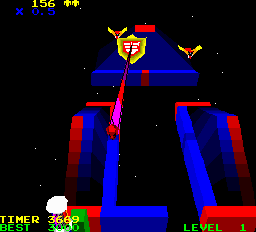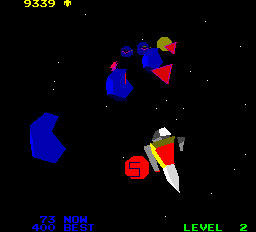Overview
Not to be confused with the Isaac Asimov inspired movie; I, Robot is an arcade game designed by David Theurer and published by Atari Inc. in June 1984. It has the distinction of being the first commercially released arcade game with filled 3D polygon graphics, or as the game puts it:
The first video game with real time computer generated mathematically perfect solid 3 dimensional objects and no hidden surfaces.
Only wireframe 3D graphics had been used before in arcade hits such as Tempest, Star Trek: Strategic Operations Simulator, and Star Wars.
I, Robot was very innovative for its time and used the graphics hardware to introduce new gameplay features, such as camera control and the Doodle City mode. However, the innovation and the abstract nature of the game may have been a bit much for players and the game failed commercially; only about a thousand units were made and a planned Atari 2600 port was canceled.
The game controls consist of an analog stick with a fire button and two separate start buttons that can be used to zoom the camera in or out during gameplay.
Gameplay
Land levels
 Zapping the shield in a land level.
Zapping the shield in a land level.I, Robot puts the player in control of the titular robot; a legless, hovering robot that is tasked with destroying a large Evil Eye observing the playfield. The playfield consists of platforms which the robot can traverse. The robot can also jump (automatically) across platforms in the cardinal directions (not diagonally). The eye opens and closes at regular intervals, turning red for a moment when fully opened. A red eye will instantly blast a jumping robot to smithereens, forcing the player to keep track of the eye's phase while navigating the level.
To complicate things further, each level has enemies that travel the playfield in various ways and must be avoided or shot. The enemies include flying birds, dolphins that swim horizontally between platforms and multi-colored balls that roll towards the player. Later levels even feature "Point of View killers" that force the player to change the camera view. A bonus timer also ticks down and kills the robot if it reaches zero.
There are two colors of platforms, blue and red. Walking over red platforms paints the platform blue and releases energy that weakens the shield of the Eye. The object is to paint all platforms blue, destroying the shield and allowing the player to jump in front of the Eye for a final blast. Jumping across regular blue strips creates a new platform which can be used to reach new places.
Every three levels, after destroying the eye, the player can enter a pyramid where he has a chance to collect as many jewels as possible for bonus points.
Space levels
 Flying through a space level.
Flying through a space level.A space level takes place after each land level. The player traverses to the next land level by flying across space while shooting and dodging oncoming bonus objects. The objects include triangular score bonuses, asteroids that must be shot multiple times and flying saucers. The letters "I ROBOT" also appear in the space segments. Collecting all of these letters during several sequential levels gives a bonus.
Every fourth level, a big floating head appears instead. The head fires projectiles, all of which must be shot to avoid dying. Shooting the head turns it away from the player and makes the projectiles easier to hit. The head can not be destroyed; the player must simply survive for about twenty seconds.
Transporters
Some land levels have transporters that can be used to skip directly to later levels, giving a score bonus after completing the new level.
Scoring
I, Robot features a surprisingly elaborate scoring system. Shooting enemies or space objects yields points depending on how close the object was, while other bonuses can be received for beating or tying the best time on the level. The camera view also contributes heavily to the score; the closer the view, the bigger the score multiplier due to limited visibility.
Doodle City
 Doodle City mode.
Doodle City mode.Doodle City, the "ungame" mode, can be selected instead of the main game after inserting credits and pressing the start button. In this mode, the joystick and buttons are used to paint pretty pictures on the screen with different polygonal objects. One credit gives three minutes of doodle time. The regular game can also be started from Doodle City, but one or two lives are taken off depending on how much time the player spent doodling.
Log in to comment